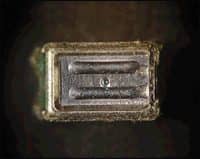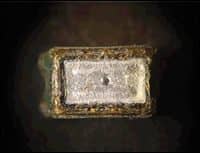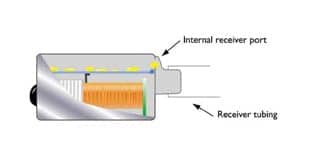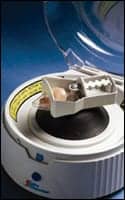Since the advent of ITE hearing instruments, the efficiency, reliability, performance, and life span of such devices has been limited by cerumen (earwax) buildup within its key internal component: the receiver.
The problem is a large one. The management of cerumen continues to be a challenge for dispensing professionals, consumers, and the industry alike. Performance and reliability issues—as well as repair and return costs—would likely improve significantly if there were a way to eliminate wax-related receiver problems. MarkeTrak VII1 shows that 74% of consumers are satisfied with the “frequency of cleaning” required for their hearing aids, 79% are satisfied with the reliability of the aid, and 66% are satisfied with the ongoing expense.
Historically, the quest for managing cerumen—whether in the form of a wax guard or collection device installed within the hearing aid itself or as a counter-top apparatus—has yielded limited success. To solve this complex problem, we take an analytical look at what cerumen is and explore how to remove it safely and thoroughly.
The Nitty-Gritty on Earwax
Typical cerumen is composed of solid, liquid, and gaseous elements. It has acids, fats, cholesterol, lipids, oils, inert matter, and even heavy metals. Each cerumen component has its own vapor pressure, specific gravity, particle mass, molecular structure, and bonding characteristic. Cerumen is also acidic, ranging from 4.0 to 6.1 on the pH scale.

|
| FIGURE 1. Microscopic top view of new receiver diaphragm. |

|
| FIGURE 2. Microscope top view of deteriorated receiver diaphragm suspension that has been invaded by cerumen. |
Complicating the issue is that the most common form of cerumen is classified as “wet” or “liquid” cerumen. Liquid cerumen has oily, fatty, acidic characteristics, but lacks the cholesterol esters and wax esters of “dry” cerumen. Liquid cerumen is often undetected during otoscopic examination. Although it will harden over time, it is this type of cerumen that most readily invades ear-worn instrument components. (For more information on cerumen, its origins, composition, and management in ITEs, see Ballachanda,2 Hain,3 and Agnew.4)
In fact, cerumen accounts for 70% to 80% of hearing instrument failures. Every time an ITE instrument is inserted in the ear, there is the possibility of wax entering the vent or receiver. While wax entering a vent can be dealt with fairly easily by removing it with a pipe cleaner or flexible wire, wax in a receiver port is more problematic. In these situations, care should be taken when mechanically removing the wax, because one can make the problem worse by forcing the wax deeper into the receiver tubing or the receiver itself, which could cause permanent failure.
The ear-worn instrument receiver may also become saturated with cerumen over time as a result of the vaporization4 and capillary action of liquid cerumen (Figures 1 and 2). The receiver itself is electrically charged, drawing atomized cerumen into all areas of the receiver by the charged, sound-generating coil.
The receiver further acts as a heat sink. During the heating cycle caused by the warm ear and the heat generated due to electrical operation, it is likely that a “creep factor” causes the wax to flow into the receiver (Figure 3). The cooling cycle, which occurs during the “off” mode, facilitates congealing the liquid cerumen within the receiver.

|
| FIGURE 3. Cross-sectional illustration shows wax accumulation on diaphragm and blockage of internal receiver port. |
The resulting added mass of cerumen on the receiver diaphragm causes low-output distortion and loss of high-frequency response. A more insidious process occurs as the acidic compounds within the cerumen slowly deteriorate the diaphragm suspension, resulting in receiver failure.
Getting Caught In the Wax Trap
Virtually every hearing instrument manufacturer has either developed or licensed one or more designs to shield or divert cerumen away from the instrument. Springs, filters, and screens are widely used as “traps” within the receiver tubing, but many of these devices quickly become blocked or clogged, requiring replacement. Furthermore, the liquid form of cerumen seeps past these components and into the receiver.
Similarly, many products have been engineered to manage cerumen impaction. These include heaters, suction pumps, and vacuum domes. Desiccants have been developed to dry and sanitize ear-worn devices in an effort to return them to normal operating specifications. Solvents have been developed to deodorize, disinfect, and free the foreign obstructions from devices. Vacuum systems have been incorporated into many designs to suction cerumen out of receiver tubing.
While in wide use in the hearing industry today, none of these systems has performed with optimum results. All have, to one degree or another, addressed the accumulation of cerumen impacting receiver tubing. None, however, has addressed cerumen buildup within the receivers themselves (Figure 3).
From Cooling Fans to Centrifuges
What can be used to effectively remove cerumen from within the receiver and return hearing instruments to operating specifications? To test the possibility of spinning a device to eject cerumen out of the receiver, we simply taped a clear pill box to the blade of a small cooling fan. A hearing device was examined to ensure that there was no debris in the receiver tubing. The device was then secured inside the pill box, and the box was spun for 1 minute. At the end of the test cycle, the hearing device was removed and the pill box was closely inspected for any matter that could have been ejected. A visible trace of earwax had accumulated on the wall of the box.
Encouraged by the initial test result, we decided to investigate further the use of centrifugal force. Centrifugal accelerators have been used in the scientific community for nearly 100 years, primarily in laboratories. Simple centrifuges are used in biology and biochemistry for isolating and separating biomolecules, or whole cells. They vary widely in speed and capacity. Molecular biology laboratories use microcentrifuges extensively. These benchtop centrifuges typically operate at high RPMs and can generate high gravitational forces.
In fact, early tests utilized laboratory centrifuges operating at high RPMs. While cerumen solids and liquids were ejected from the hearing instruments mounted on the rotor, the high forces often resulted in the destruction of the receiver components.
Letting Physics Do the Work
A series of experiments was performed with the goal of determining forces capable of cleaning the receiver without damaging its components. During those experiments, rotor speed, instrument mounting distance from center, and cycle duration were varied.
Once the correct combination of factors was reached, the centrifugal effect of the resulting product, the SpinDoctor™, generated a precise gravitational force on a given device (based on speed selection) of 6 to 9 Gs with a spin cycle of 20 seconds. This proved to be beneficial for removing cerumen and other debris.
Applying the principles of angular acceleration to a complex body excretion such as cerumen addresses a multitude of chemical elements in various states. By introducing centripetal acceleration to this chemical composite, cerumen is sheared into particles of varying mass, density, specific gravity, vapor pressure, molecular structure, and bonding characteristics. The shearing action of the angular force enables low vapor pressure contaminants and volatile toxins to evaporate. The remaining lipids, cholesterol, and other high-mass components of cerumen are then ejected by their own inertia.

|
| FIGURE 4. First prototype of centrifugal wax remover with hub rotor and ring of expelled wax from numerous tests. |
To test the concept, a number of in-house prototypes were developed (Figure 4). These were consigned to the instrument repair department. The goal of this investigation was twofold: 1) Would the devices withstand hours of use on a daily basis? and 2) Would the utilization of centrifugal force be effective in returning “dead” or weakly/intermittently performing instruments to performance specifications?
Over a period of 22 months, none of the prototypes exhibited failure. During the same period, the repair department reported that 65% of instruments sent in for the reasons stated above were returned to performance specifications. The success rate was higher with in-warranty repairs, lower for older instruments.
In cases where performance was not restored, replaced receivers were disassembled and examined. In most cases, the polyurethane component of the receiver diaphragm suspension had “unzipped,” exhibiting a mushy quality, and had begun to separate from the diaphragm.
However, it was noted that existing debris in the receiver tubing—usually dry and often compacted—could impede the speedy clearing of cerumen from within the receiver. We discovered that by injecting a small amount of fluid (50% alcohol, 50% hydrogen peroxide) and agitating the liquid, the debris in the receiver tubing was put into a suspended state. It was then quickly ejected from the receiver tube during the centrifuging cycle, clearing the way for the ejection of cerumen within the receiver.

|
| FIGURE 5. Final version of SpinDoctor™ Centrifuge with typical ITE seated in adjustable rotor. |
The next step was to evolve the prototype into a functioning piece of clinical equipment. The prototype, while totally functional, was bulky, heavy, and essentially shop-built. The safety lid on the prototype quickly became coated with the debris ejected from the hearing instruments (Figure 4). While this was reaffirmation of the cleaning ability of the SpinDoctor, it would not have been an attractive or hygienic feature for the office.
To resolve hygiene issues and provide a quick and easy system for mounting a hearing instrument to the rotor, a unique rotor collection system was designed (Figure 5). A drum-style rotor was first developed, but required a collection of counterbalances that varied in weight when cleaning a single instrument. Wax containment was still an issue. A revision of the rotor design featured an adjustable counterbalance to accommodate instruments ranging in size and weight from mini-CIC to full-shell ITEs. Wax containment was resolved by developing a clear, high-impact plastic “nose cone” into which the tip of a hearing instrument would be placed.
Summary
Cerumen remains the leading cause of mechanical failure in hearing instruments. No one wins when hearing instruments fail. Time is lost, confidence is eroded, and the consumer’s frustration grows. Although ear wax has clogged, degraded performance, or damaged hearing aids and their components throughout the history of the hearing industry, there have been few viable methods for removing cerumen once it enters the hearing aid.

|
| More on cerumen “A New System to Protect Hearing Aids from Cerumen and Moisture.” By Eric Branda, AuD, and Josef Chalupper, PhD. April 2007 HR. “Resolving a Root Cause of Failure to Fit: Re-examining the Ear Canal.” By Max Stanley Chartrand and Glenys Anne Chartrand. March 2006 HR. |
In an overwhelming majority of cases, hearing instruments maintain their optimum specifications only if the pathway or port from the receiver remains unobstructed. This requires regular cleaning, performed by either a hearing care professional or the consumer. The cleaning regimen should, of course, include exterior cleaning, moisture control (eg, opening the battery door at night), and inspections of microphone and receiver port for blockage. Wax within the receiver tube may be carefully removed with a wax pick or vacuum system. Wax buildup in the receiver tube, however, is a sure sign that the cerumen has invaded the internal portion of the receiver. That cerumen can only be removed by precise centrifugal force.
Are centrifuges the ultimate solution for wax removal from hearing instruments? Our findings demonstrate that the SpinDoctor can, in fact, resolve the key issue with hearing device failure—wax accumulation of the diaphragm and blockage to the internal receiver port—and suggest that it is an essential addition to every dispensing practice.
References
- Kochkin S. MarkeTrak VII: Customer satisfaction with hearing instruments in the digital age. Hear J. 2005;58(9):30-43.
- Ballachanda B. The Human Ear Canal. San Diego: Singular Publishing Group;1995.
- Hain TC. Earwax. Available at: www.dizzinessandbalance.com/disorders/hearing/wax2.html. Accessed: April 9, 2007.
- Agnew J. Toward a better understanding of cerumen. Hearing Review. 1994;1(4):16-20.





